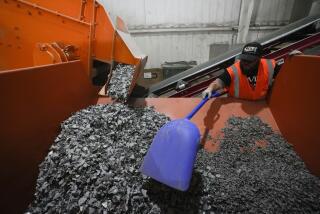Motor of the Sun : Ojai mechanic creates a space-age version of a no-fuel, no-pollution, 1898 solar-powered invention.
- Share via
Tom Miller, an Ojai mechanic, is a technician in the Renaissance style. It was such a mechanic who, working for Galileo, probably said: “Boss, if I can fit some bigger lenses on this spying tube you brought back from Holland, we can use it for astronomy instead of watching the neighbors across the piazza.”
Miller, whose regular work in our century and our county has been in classic car repair, also went to work for a modern master scientist--John Ziegler of NASA.
Ziegler, credited with working out the U.S. moon-launching module, had left space work in the 1970s to research solar power.
What he sought to refine was not a crude spyglass chanced upon during a quest, but something almost as obscure--a device first displayed at a Pasadena Ostrich Farm about 100 years ago.
It was a solar-powered, 15-horsepower motor that pumped 1,000 gallons of water a minute to irrigate the citrus and ostrich compound.
The device, which used the sun’s heat to generate steam for its own engine, had been invented in 1898 by Aubrey Eneas, an Englishman. Pasadena was a hospitable site for its debut because that city, exactly 100 years ago this year, had begun “going solar” for its home hot water heating.
“Everybody had one,” enthused the Pasadena Daily Evening Star in 1899. But these home rigs were only for hot water heating, not for running engines.
What interested Ziegler, and what he hired Tom Miller to build for him, was a space-age version of Eneas’ no-fuel, no-pollution and practically no-cost solar motor.
That’s what is sitting on a hillside above Ojai today. Well, not exactly. It’s version No. 5. A lot of kinks in the original idea have been worked out.
It still looks like the original--startlingly evocative of a TV satellite dish. The technology is similar to a satellite dish, actually.
In Miller’s device--made from Masonite, Mylar and metal hoops--the sun’s heat is gathered by the dish and boils water in a hollow central rod. In a TV dish, usually made of plastic, the rod gathers broadcast signals radiated from a satellite. Miller’s dish gives you steam. Radio Shack’s gives you sitcoms.
Also true to its original intention, Miller’s rig is in use on a remote farm. The Ostrich Farm version provided steam for the motor of an irrigation pump. So does the Ojai version, but with a twist.
This winter, if we have cold spells like last year’s, Miller will mix solar heated water from his turbine’s storage tank with the irrigation water in the grove’s plastic pipes, which are buried underground.
Thus, the sun’s glaring energy can be stored and circulated underground to banish frost on winter nights. No pollution-producing smudge-pots or noise-producing aircraft engine blowers necessary.
Miller is working independently now, since Ziegler is more than 90 years old. And he has plenty to do. There are plenty of additional farm applications for Miller’s current rig, he said. They include water pumping and electricity for agribusiness sites such as cotton acreage that is remote from the farm headquarters.
Another is power and refrigeration for packing plant facilities on isolated cattle ranches. The refrigeration process in this case is called “absorption cooling” which is the name of the technology that uses steam or heat similar to what goes on in a propane gas refrigerator aboard a Winnebago mobile home.
“Remote power is worth twice (as much) as town (power),” remarked Miller during an interview in which he rivaled Calvin Coolidge in taciturnity.
What he means by “remote power” is having to string power lines at a cost to the farmer of thousands of dollars a mile. Miller’s device can be built wherever you need it, for under $3,000.
And then, of course, there’s no electric bill.
Miller is seeking funding for more research but first he recommends that anyone interested in becoming involved with solar power first read the book “A Golden Thread,” by Ken Butti and John Perlin.
Inquiring minds may have picked up on the fact that this story is set far from the mainstream of industrial research. Amory Lovins, America’s leading advocate of solar power, has written about such phenomena tersely: “The most interesting solar research tends to be done outside the official government-sponsored research community--and at a pace far outstripping the government’s ability to find out what’s being done.”
Translation: Who in government or industry wants us to have cheap generators and free power? How can you tax, regulate, meter or bill people for it?
The only thing solar has going for it is a good deal for the consumer and the environment. Which is more than good enough for me.
* FYI
The book Tom Miller recommends reading before getting involved with solar power is: “A Golden Thread: 2,500 Years of Solar Architecture and Technology” by Butti and Perlin. Available at your local Ventura County Library branch.






